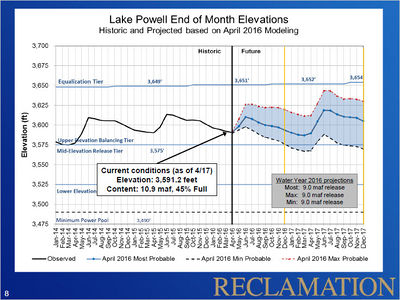|
|
| Line 23: |
Line 23: |
| | |style="width:60%; font-size:120%;"| | | |style="width:60%; font-size:120%;"| |
| | | | |
| − | ==[http://www.usbr.gov/uc/water/crsp/cs/gcd.html '''Current Status, Operations, and Forecasts''']==
| |
| | ==2017 Operating Tier== | | ==2017 Operating Tier== |
| − | The operating tier for water year 2017, established in August 2016, is the Upper Elevation Balancing Tier, with an initial water year release volume of 8.23 maf and the potential for an April 2017 adjustment to equalization or balancing releases. Based on the current forecast, an April adjustment to balancing releases is projected to occur and Lake Powell is currently projected to release 9.0 maf in water year 2017. This projection will be updated each month throughout the water year. | + | The operating tier for water year 2017, established in August 2016, is the Upper Elevation Balancing Tier, with an initial water year release volume of 8.23 maf and the potential for an April 2017 adjustment to equalization or balancing releases. Based on the current forecast, an April adjustment to balancing releases is projected to occur and Lake Powell is currently projected to release 9.0 maf in water year 2017. This projection will be updated each month throughout the water year. [http://www.usbr.gov/uc/water/crsp/cs/gcd.html] |
| | | | |
| | |}<!-- | | |}<!-- |
Reservoir Elevations
|
|


|
Inflows to Lake Powell
|
|

USBR Weekly Water Reports
USBR Monthly/Annual Reports
Snow Pack Reports
U.S. Drought Monitor
|
|
Water Flow Gages
|
|
|
Presentations and Papers
|
|
2016
2015
2014
2013
|
Other Stuff
|
|
In addition to daily scheduled fluctuations for power generation, the instantaneous releases from Glen Canyon Dam may also fluctuate to provide 40 megawatts (mw) of system regulation. These instantaneous release adjustments stabilize the electrical generation and transmission system and translate to a range of about 1,200 cfs above or below the hourly scheduled release rate. Under system normal conditions, fluctuations for regulation are typically short lived and generally balance out over the hour with minimal or no noticeable impacts on downstream river flow conditions.
Releases from Glen Canyon Dam can also fluctuate beyond scheduled releases when called upon to respond to unscheduled power outages or power system emergencies. Depending on the severity of the system emergency, the response from Glen Canyon Dam can be significant, within the full range of the operating capacity of the power plant for as long as is necessary to maintain balance in the transmission system. Glen Canyon Dam typically maintains 30 mw (approximately 880 cfs) of generation capacity in reserve in order to respond to a system emergency even when generation rates are already high. System emergencies occur fairly infrequently and typically require small responses from Glen Canyon Dam. However, these responses can have a noticeable impact on the river downstream of Glen Canyon Dam.
The Upper Colorado River Basin regularly experiences significant year to year hydrologic variability. During the 16-year period 2000 to 2015, however, the unregulated inflow to Lake Powell, which is a good measure of hydrologic conditions in the Colorado River Basin, was above average in only 3 out of the past 16 years. The period 2000-2015 is the lowest 16-year period since the closure of Glen Canyon Dam in 1963, with an average unregulated inflow of 8.51 maf, or 79% of the 30-year average (1981-2010). (For comparison, the 1981-2010 total water year average is 10.83 maf.) The unregulated inflow during the 2000-2015 period has ranged from a low of 2.64 maf (24 percent of average) in water year 2002 to a high of 15.97 maf (147 percent of average) in water year 2011. The water year 2015 unregulated inflow volume to Lake Powell was 10.174 maf (94 percent of average), which, though still below average, was significantly higher than inflows observed in 2012 and 2013 (45% and 47 percent of average, respectively).
|
|



